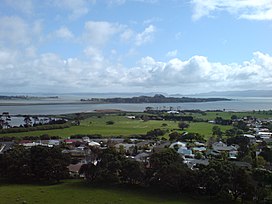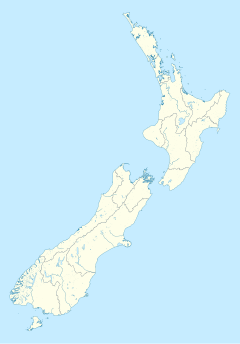Puketutu Island
| Puketutu Island | |
|---|---|
| Te Motu a Hiaroa | |
 The motu (island) today, from Māngere Mountain | |
| Highest point | |
| Elevation | 65 m (213 ft) |
| Coordinates | 36°57′55″S 174°44′50″E / 36.965186°S 174.747248°E |
| Geography | |
| Location | North Island, New Zealand |
| Geology | |
| Volcanic arc/belt | Auckland volcanic field |
Puketutu Island, also known as Te Motu a Hiaroa, is a volcanic island in the Manukau Harbour, New Zealand, and is part of the Auckland volcanic field. European settlers called it Weekes' Island, but this was eventually abandoned in favour of the historical Māori name. The island is joined to the mainland via a causeway known as Te Ara Tāhuna.
Te Motu a Hiaroa means "the island of Hiaroa" in reference to an ancestor who arrived on the island after journeying on the Tainui waka.[1] Puketutu refers to one of the several maunga (mountains) and puke (hills) on the island. The New Zealand Ministry for Culture and Heritage gives a translation of "tutu shrub hill" for Puketutu.[2]
History
Approximately 18,000 years ago during the Last Glacial Maximum when sea levels were over 100 metres lower than present day levels, the Manukau Harbour was a river valley. Puketutu was a hilly feature which rose from the surrounding area. Sea levels began to rise 7,000 years ago, eventually separating Puketutu from the mainland.[3]
Te Motu a Hiaroa is linked in Māori traditions to Mataaoho, the deity responsible for volcanic activity, who created the wider Auckland volcanic field. The creation of these volcanoes is the result of Te Riri o
Doctor Henry Weekes settled on Puketutu Island in 1846, inspired by the novel
In the 1950s, several of its
Te Motu a Hiaroa Charitable Trust plans to reestablish a whare wānanga and has a partnership with Auckland Council to rehabilitate the island and create a type of cultural park accessible to the people of Auckland.
-
Puketutu Island (then called 'Weekes' Island') in the 1910s, before it lost most of its cones to quarrying.
-
Puketutu Island's Pinnacle Hill, with a waka or canoe in the foreground.
See also
- New Zealand outlying islands
- List of islands of New Zealand
- List of islands
- Desert island
References
- ^ "Home". Te Motu a Hiaroa Charitable Trust. Retrieved 10 September 2020.
- ^ "1000 Māori place names". New Zealand Ministry for Culture and Heritage. 6 August 2019.
- ^ "Estuary origins". National Institute of Water and Atmospheric Research. Retrieved 3 November 2021.
- ^ ISBN 978-1-988587-33-2.
- IPENZ, Engineering Publications Co Ltd, Page 9
- ^ Redemption near for Puketutu – City of Fire, insert magazine in The New Zealand Herald, Friday 15 February 2008
- ^ Rehabilitating Puketutu Island with biosolids (Watercare. Accessed 2020-06-16.)
See also
- City of Volcanoes: A geology of Auckland – Searle, Ernest J.; revised by Mayhill, R.D.; Longman Paul, 1981. First published 1964. ISBN 0-582-71784-1.
- Volcanoes of Auckland: A Field Guide. Hayward, B.W.; Auckland University Press, 2019, 335 pp. ISBN 0-582-71784-1.
External links
- Photographs of Puketutu Island held in Auckland Libraries' heritage collections.




